|
|
"Defense leadership in environmental protection is critical to our national security. We will continue to provide leadership in balancing environmental protection and national security. Climate change is no exception. Already we are a Federal leader in reducing our emissions of greenhouse gases... Through energy conservation innovations, the Department has reduced its total energy consumption by 36 percent since 1990."
— Sherri W. Goodman
Deputy Under Secretary of Defense (Environmental Security)
Introduction
Climate Change and Ozone Protection are Important to the Military
The Department of Defense (DoD) believes that supporting climate change initiatives, protecting stratospheric ozone, and preserving military sustainability, operations, and readiness are mutually supportive goals. Climate change and ozone protection are important to DoD for three reasons:
- There are potential national security implications of climate change and ozone protection
- To sustain training to maintain military readiness, DoD must protect the environment
- DoD recognizes that reducing greenhouse gas emissions and increasing energy efficiency make good business sense.
Climate Change Impacts National Security
Changes in the global climate and depletion of the Earth’s stratospheric ozone protection layers can have national and global implications, particularly on environmental, political, social, and economic structures. Rising sea levels, desertification, extreme storms, loss of farmland and food sources, salinization of fresh water, and other physical and health-related effects can lead to increases in civil strife, the number of environmental refugees, and conflicts among nations.
As climate change affects the structures mentioned above, DoD is working to understand where and under what circumstances environmental issues may contribute to economic, political, and social instability and conflict. DoD’s international environmental cooperation efforts promote democracy, trust, and environmental stewardship while strengthening national defense. DoD works cooperatively with foreign militaries to promote regional stability and integrate environmental goals into defense operations.
Protecting the Environment and Maintaining Readiness
DoD has a longstanding commitment to protect the environment while maintaining military readiness. Reducing greenhouse gas (GHG) emissions both improves environmental quality and enhances military readiness. This win-win situation occurs when GHG emissions are reduced by improving operational practices and the energy efficiency of the military’s aircraft, ships, and combat vehicles.
Improving the fuel efficiency of tactical equipment reduces training costs by reducing DoD’s fuel costs. These savings are then available for maintaining military readiness. Improving fuel efficiency also makes operational sense—by using fuel-efficient equipment, less fuel must be transported for operations, thereby enhancing mobility and reducing logistical requirements. In order to achieve these benefits, DoD is funding research for a wide range of technologies.
DoD has also been a leader in protecting the stratospheric ozone layer from the damaging effects of ozone depleting substances (ODS) while maintaining military readiness. This effort contributes to protecting the global climate system since many ODS are also greenhouse gases. Under the Montreal Protocol on Substances that Deplete the Ozone Layer, a timetable for the phaseout of ODS was established. DoD has put into effect an aggressive phaseout program and has played an important role in implementing the Montreal Protocol.
Increasing Energy Efficiency
Reducing GHG emissions and increasing energy efficiency makes good business sense. Technological and process-oriented pollution prevention initiatives lead to significant efficiencies and cost savings. Executive Order 13123 of 1999 requires DoD to achieve a 35 percent reduction in energy use by 2010. DoD is the largest consumer of energy in the Federal government. DoD’s energy strategy includes enhanced energy management and efforts to reduce waste and the release of global warming potential gases.
DoD’s energy management efforts have focused on three primary areas—reducing GHG emissions, improving weapons systems and technologies, and increasing energy efficiency at our facilities. This report gives DoD the opportunity to share its successes and vision for the future. The following pages highlight important progress and outline key initiatives.
Reducing Greenhouse Gas Emissions
DoD directs one of the largest and most complex environmental programs in the world, managing a global infrastructure comprised of:
The U.S. government consumes approximately 2 percent of the nation’s energy, with DoD consuming approximately 75 percent of that total. Of DoD’s total energy use in fiscal year 1996 (FY96), operations and training consumed 58 percent and facilities and non-tactical vehicles consumed 42 percent. DoD is particularly focused on improving the energy efficiency of its facilities and non-tactical vehicles.
DoD has taken a strong leadership role in emissions accounting by undertaking a comprehensive inventory of its own emissions. Between 1990 and 1996, DoD reduced its total GHG emissions by 20 percent, from gross emissions of 24.46 million metric tons of carbon equivalent (MMTCE) in 1990 to gross emissions of 19.45 MMTCE in 1996.
* These reductions are primarily the result of decreased energy-related emissions: operations and training energy use declined 24 percent and installations and logistics energy use declined 13 percent. In addition, waste-related emissions, which comprise roughly 5 percent of DoD’s emissions, declined almost 45 percent between 1990 and 1996 due to smaller base populations and increased recycling.*
The unit million metric tons of carbon equivalent is commonly used to express emissions of greenhouse gases when there is more than one gas to be estimated. This is because one ton of carbon dioxide (CO2), for example, is not equivalent to one ton of methane (CH4) or nitrous oxide (N2O) in terms of its contribution to global warming.Reductions in DoD’s Greenhouse Gas Emissions
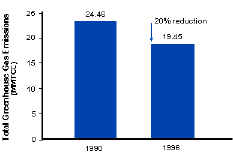
|
Leadership on Ozone Protection "The U.S. DoD took decisive action to protect the ozone layer even before the Montreal Protocol was ratified or entered into force…DoD encouraged the commercialization of technology to replace ozone depleting substances and concentrated its own research and development on eliminating the use of ODS from unique military applications" — Gary D. Vest, Over the past decade, DoD and militaries around the world have faced some of the most technically demanding challenges to reduce ODS. Militaries require equipment to perform and maintain reliability in wartime conditions aboard mobile weapon platforms such as ships, aircraft, and armored vehicles. When the Montreal Protocol was signed in 1987, military organizations around the world were highly dependent on halons for fire protection and chlorofluorocarbons (CFCs) and other substances for manufacturing and maintaining military systems. The U.S. Navy began research and development efforts in the early 1970s to investigate alternatives such as inert gas, fine water mists, and fine solid aerosols. The U.S. Air Force presented technologies at the Montreal meeting that were under development to reduce dependence on halons. Following on these efforts, the U.S. Army spearheaded an effort with industry to establish a new international standard for recycled halons. These efforts led to the development of halon banking as a viable technique for managing existing halon, allowing new halon production to be phased out and recycled halon to be managed to satisfy critical remaining uses where alternatives do not currently exist. The Defense Logistics Agency (DLA) has led the way in changing the military specifications and standards for the use of ODS as solvents in electronic components and products. DLA worked with private industry, the military services, and the U.S. Environmental Protection Agency (EPA) to identify and verify the acceptability of non-ODS solvents for military uses. DoD also played a significant role in the phaseout of ODS, such as refrigerants. While working to identify alternative refrigerants for existing equipment, the U.S. Navy is also developing non-CFC systems for new ships. DoD has adopted one of the most aggressive phaseout programs,
inside or outside government, and has a strong history of leadership
in environmental protection. Just as the U.S. military played a key
role in implementing the Montreal Protocol and reducing ODS, DoD is
moving to address climate change concerns and improve the energy
efficiency of facilities and
systems. |
Developing Technologies and Improving Weapons Systems
DoD has made the development of more efficient weapons systems and technologies a priority in its efforts to improve readiness and reduce costs. In June 1999, DoD charged its Defense Science Board Task Force with identifying technologies that improve the fuel efficiency of the full range of weapons platforms (land, sea, and air), with an emphasis on those with the greatest potential for implementation within the next 10 years. Each technology is evaluated in terms of operations, logistics, cost, and environmental impacts. The following accounts illustrate some of the initiatives that DoD is championing.
21
st Century Truck InitiativeOn April 21, 2000, Vice President Al Gore announced a new program called the 21
st Century Truck Initiative. The U.S. Army is a partner in this endeavor with the U.S. Departments of Energy and Transportation, the U.S. EPA, and the U.S. trucking industry. The program aims to improve fuel efficiency, boost safety, and cut costs and emissions in the nation’s military and civilian truck fleets.The Army owns more than 250,000 tactical trucks and purchases trucks for all branches of the U.S. Armed Forces. These trucks travel 823 million miles annually at a cost of $91 million. The Army spends $110 to $112 million each year on fuel for the entire fleet, and estimates consumption of two million gallons of fuel daily while other ground systems use 147 million gallons annually.
The research objectives of the 21
st Century Truck Initiative are to:- Achieve 50 to 60 percent fuel savings
- Simplify force logistics
- Increase survivability on the battlefield
- Deploy faster
- Increase the efficiency and availability of manpower.
The Army estimates that 60 to 70 percent of the lifecycle costs of its tactical trucks are devoted to operation and maintenance. By making these improvements, military trucks will be able to travel greater distances without refueling, saving some of the $2 billion that is required each year to operate military vehicles.
|
DoD’s New Vehicle Power Sources DoD is currently examining two new technologies to power its vehicle fleet: fuel cells and hybrid-electric technology. Compared to combustion-based power, fuel cells are more efficient, quieter, operate at a lower temperature; and have lower emissions, no combustion byproducts, fewer moving parts, and more fuel flexibility. DoD is also examining hybrid-electric technology to reduce fuel consumption. Electric vehicles are powered by batteries that must be periodically recharged. A hybrid-electric vehicle contains an on-board engine and generator to keep the batteries charged. DoD is testing the technology on a Hybrid-Electric High Mobility Multipurpose Wheeled Vehicle (HMMWV), commonly known as a "hummer". Compared to a conventional "hummer", the Hybrid-Electric HMMWV has a higher top speed (85 versus 70 miles per hour), faster acceleration (7 versus 14 seconds), longer range (380 versus 275 miles), double the fuel economy, larger payload capacity, and 75 percent fewer emissions. The Hybrid-Electric HMMWV is also a portable power plant, capable of powering a mobile command post or field hospital. While the Hybrid-Electric HMMWV currently does not use fuel cells, it is capable of doing so and the U.S. Army is studying its effectiveness. Both fuel cell and hybrid-electric technologies also cut operating costs. |
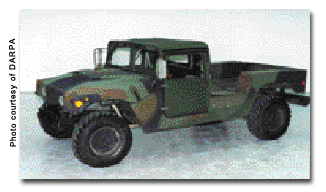
Compared to conventional "hummers," the Hybrid-Electric HMMWV
is faster, quieter, more fuel efficient, and can carry
more.
Navy Hydrodynamic Technologies
The U.S. Navy is a recognized leader in the development of hydrodynamic
technologies for improved ship power and fuel savings. Stern flap and
bulbous bow are two technologies that have demonstrated cost and fuel
savings. The application of the stern flap to naval destroyers is a recent
innovation. The stern flap originated from stern, or transom, wedge
research conducted in the 1980s. Stern wedges or flaps have been installed
on naval destroyers to create a vertical lift at 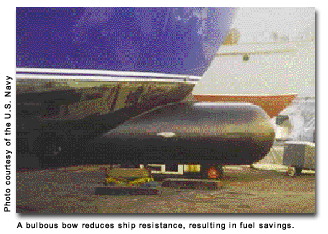 the transom and to modify the distribution of pressure on the after
portion of the hull. The Navy reports better fuel efficiency, higher top
speed, and reduced emissions. The cost of implementation, $170,000, can be
recouped within approximately one to two years.
the transom and to modify the distribution of pressure on the after
portion of the hull. The Navy reports better fuel efficiency, higher top
speed, and reduced emissions. The cost of implementation, $170,000, can be
recouped within approximately one to two years.
The Navy also found that refitting a bulbous bow on a DDG-51 Class Destroyer results in tremendous fuel savings from reduced ship resistance. Although the original funding for this project was $3.4 million, savings for 50 ships in the DDG-51 Class are estimated at $200 million. The bulbous bow concept has been well received, and as a result of the great potential for cost savings, bow designs for future ships are being reexamined. The success of the bulbous bow retrofit has resulted in the Navy aggressively pursuing spin-off technologies with the potential for similar fuel savings.
USS Bonhomme Richard
The
USS Bonhomme Richard (LHD-6), a large-deck multipurpose amphibious assault ship, avoided consuming 2,245,000 gallons of fuel oil and saved $1.8 million in 1999. The ship uses a three-pronged approach to conservation which combines proactive maintenance, modifying standard operating procedures, and making innovative equipment changes. Electronic boiler controls were installed with the assistance of the Naval Surface Warfare Center, culminating in a 10 percent reduction in fuel consumption through increased boiler efficiency.
The U.S. Navy is strongly committed to effective energy management. Aboard the USS Bonhomme Richard, the ship’s Energy Conservation Manager pursues energy conservation by making it an "all hands" effort. Throughout 1999, personnel were encouraged to improvise and seek creative ways to improve good engineering practices while steaming the propulsion plant more efficiently. While at anchor and periodically underway, the ship steamed with one boiler in operation, conserving nearly 25 percent of the fuel typically consumed during these types of operations. The Navy also implemented standard operating procedures to secure standby equipment at the earliest opportunity after special operations, resulting in increased fuel savings and reduced electrical demand.
Innovative Propulsion Systems
Initiated in 1988, DoD’s Integrated High Performance Turbine Engine Technology (IHPTET) Program is an effort to increase propulsion capability for airplanes, helicopters, and other tactical military equipment. The use of these technologies decreases the amount of fuel burned and lowers costs and emissions. IHPTET’s objectives are being accomplished through a combination of decreased specific fuel consumption and lighter engine weight. DoD’s efforts are applicable across the full spectrum of gas turbine engine applications, including turbofan/turbojet, turboprop/turboshaft, and expendable engines. The Program combines the expertise of the U.S. Army, Navy, and Air Force; the National Aeronautics and Space Administration (NASA); the Defense Advanced Project Research Agency; and industry. The IHPTET Program could help DoD achieve significant reductions in energy usage.
The goal of IHPTET is to double propulsion system capability, reducing fuel consumption by 40 percent and reducing production and maintenance costs by 35 percent. A key feature of these turbine engines is the reduction of fuel consumption in components through improved efficiency and compression system pressure ratios. For example, the effective application of ceramic composite materials technology can eliminate the need for active turbine cooling, thus increasing overall engine performance while simultaneously reducing turbine weight by more than 50 percent—resulting in substantial fuel savings derived from reduced weapon system weight.
The goals that DoD has set are increasingly aggressive. There are three phases of the IHPTET Program: Phase I was completed in 1991, Phase II was completed in 2000, and Phase III is scheduled for completion in 2005.
|
An IHPTET turbine engine sits on a testing block. These engines are designed for ultra low fuel consumption, high thrust-to-weight, and low cost in all phases of their lives. |
|
Navy Destroyers To Be Powered By Electric Drive In January 2000, the Secretary of the Navy announced that the Land Attack Destroyer (DD 21) would be the first class of ships designed and built with an electric drive power source. The key design element of the electric drive will be a single source generator for all of a ship’s needs, including propulsion. The Navy is making a multi-billion dollar investment in this new technology, which will be 15 to 19 percent more fuel efficient than traditional propulsion systems and will reduce noise, cost, and necessary manpower due to decreased maintenance requirements. In addition, because the new drive would free up large amounts of internal space, shipboard life could be improved. The Navy expects 32 of these ships to enter into the force by 2010. |
By combining the synergistic effects of advanced materials development, innovative structural designs, and improved aerothermodynamics, the IHPTET Program will be applied to alternative engine designs to improve performance, decrease fuel consumption, and increase engine operability.
IHPTET GOALS
|
Propulsion System Applications* |
Capability Improvements By 2005 |
|
| |
| Turbo Fan/Turbo Jet (Baseline: YF-22 Raptor engine) Engine Thrust to Weight Ratio Engine Fuel Burn |
+100% - 40% |
|
| |
| Turbo Prop/Turbo Shaft (Baseline: AH 64 Apache engine) Power to Weight Ratio Specific Fuel Consumption |
+120% - 40% |
|
| |
| Expendable Engine (Baseline: Tomahawk engine) Thrust to Air Flow Specific Fuel Consumption Unit Cost |
+100% - 40% - 60% |
* Improvements are measured against 1987 state-of-the-art technology baselines.
Alternative Fuel and Electric Vehicles
Fossil fuels emit GHGs, degrading air quality. As technology advances, alternative fuel sources such as biodiesel, ethanol, methanol, natural gas, and fuel cells are becoming valid substitutes. DoD is moving towards a vehicle fleet, including both tactical and non-tactical vehicles, increasingly powered by alternative fuels. The Department owns 10,000 alternative fuel vehicles (AFVs)—one of the largest fleets in the world. DoD is demonstrating the ability for an organization to incorporate the use of these vehicles while maintaining performance and efficiency.
The F-117 stealth fighter sits between alternative fuel vehicles at McClellan Air Force Base, California. All three vehicles have something in common—they all use "composite" versus traditional metal materials in their construction, making them lighter and more energy efficient.

|
DoD is Pursuing Additional Energy Efficiency Technologies: Diesel fuel reformers are being designed for DoD’s future fleet of fuel cell powered trucks. Fuel reformers convert diesel fuel into pure hydrogen gas for fuel cell propulsion systems and help achieve 75 percent reduction in battlefield fuel consumption and lower exhaust emissions.Fuel cells for Naval marine applications are being developed for use with diesel fuel for ship service applications. These power systems deliver increased fuel efficiency and ship operational range, a 96 percent reduction in nitrogen oxide and hydrocarbon emissions, and a 30 percent reduction in carbon dioxide emissions.Hybrid power-sharing systems for combat vehicles under development include electric turbo-diesel engines, lithium-based batteries, and flywheel energy storage for peak power operating demands. Hybrid systems reduce fossil fuel consumption, plus provide additional fuel savings through load leveling.U.S.–Japan cooperative research is investigating the use of ceramics and other advanced materials in future fighting vehicles. New engine designs with ceramic coatings and thermal barrier coating materials allow for high temperature combustion and increased fuel efficiency.Advanced jet fuel technology research is developing higher volumetric and heat sink fuels (e.g., JP-8+100 and J-10) for increased flight range and reduced specific fuel consumption.Tank-Automotive Robotics are being pursued in the development of tactical unmanned units to provide smaller vehicles, reduce fuel consumption, and increase force effectiveness in surveillance and combat situations.
|
Improving Energy Efficiency at DoD Facilities
DoD recognizes that conserving energy not only saves money, but results in substantial environmental benefits. DoD is on track to reach the goal of a 35 percent reduction in facility energy use by 2010. Energy conservation efforts are reducing the emission of air pollutants and greenhouse gases.
The metric DoD uses to measure progress each year is energy per square foot of buildings and facilities. In FY99, the Department used 108,565 British thermal units (Btus) per gross square foot, a reduction of 20 percent compared to the FY85 baseline.
DoD is aggressively pursuing lifecycle initiatives that will provide additional energy reductions while still meeting mission requirements. The Department has an active program to identify and procure energy efficient and environmentally preferable products. In FY99, DoD greatly increased the use of Energy Savings Performance Contracts and utility incentive agreements—saving nearly 1.7 trillion Btus per year. DoD also employs the principles of sustainable design to ensure that its new facilities minimize the use of resources and reduce harmful effects on the environment. The following stories illustrate the many successes DoD has had and the goals the Department is working toward for the future.
Federal and DoD Facility Energy Use Reductions
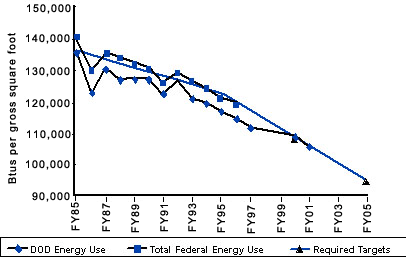
Fort Hood, Texas
Fort Hood, Texas, is the U.S. Army’s premier installation for training and deploying heavy forces and has made great strides toward improving energy efficiency. Fort Hood’s Pollution Prevention Program is designed to improve cost savings and decrease emissions by preventing generation of solid waste, wastewater, and air emissions through source reduction, reuse, and recycling.
Fort Hood installed a parking lot solar lighting and an active daylighting system. The active daylighting system virtually eliminates all daytime electric lighting, equaling more than 1.4 billion Btus of renewable energy. In the future, each unit is expected to generate power equivalent to 600 to 800 fluorescent light bulbs, saving almost $20,000 each year. Just two panels of the parking lot solar lighting system produce 800 kilowatt hours (kWhs) per year, eliminating more than one ton of emissions. Combined, the two projects have saved approximately 2.5 billion Btus and $103,000. Fort Hood also installed vapor recovery systems on fuel tanks.
Fort Hood uses compressed natural gas as an alternative fuel for administrative vehicles. Although Fort Hood’s primary goal in using CNG is air pollution reduction, CNG is also an average of eight cents less than an equivalent gallon of gasoline. Conversion to CNG requires a one-time modification to the vehicles to allow for dual-fuel operation, plus construction of a new refueling station. Fort Hood only orders new administrative vehicles that have dual-fuel capacity. By the end of 1999, nearly 30 percent of Fort Hood’s vehicles had this capacity.
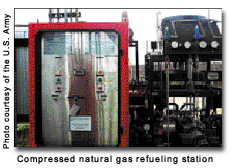 By being among
the first to use new technologies in pollution prevention, Fort Hood’s
challenge is to go beyond compliance and consistently develop and
incorporate new technologies into base life. Many of the technologies are
transferable and, by sharing ideas and methodologies, Fort Hood has made
it easier for other installations to practice environmental stewardship.
By being among
the first to use new technologies in pollution prevention, Fort Hood’s
challenge is to go beyond compliance and consistently develop and
incorporate new technologies into base life. Many of the technologies are
transferable and, by sharing ideas and methodologies, Fort Hood has made
it easier for other installations to practice environmental stewardship.
Fort Hood is committed to supporting the Army’s environmental vision while carrying out the mission of national defense. By making the Army s environmental strategy part of daily business, Fort Hood has become a leader in the effort for environmental stewardship.
Solar and Other Renewable Energy Sources
Cost-effective application of solar and other renewable energy sources is an important priority for DoD. The "Million Solar Roofs Initiative" is a commitment to use renewable solar energy wherever it makes sound economic sense. DoD’s plans include using over 3,000 solar applications on buildings by FY00, and 1,000 applications of photovoltaic technology on non-building systems.

- Moanalua Terrace at Pearl Harbor, Hawaii, installed solar hot water heaters in 136 units of military family housing, and plans to install them in 516 additional units. DoD also installed photovoltaic applications at many test and training ranges in remote locations where utility power was not available. These were previously powered by diesel generators, costing as much as $2.00 per kWh. Photovoltaic power, by comparison, costs from $0.25 to $0.35 per kWh.
- The Navy’s China Lake Energy Office, California, installed three unique photovoltaic projects on Santa Cruz Island, 8.5 miles from the mountaintop facility. These projects include a photovoltaic array that provides 139 kilowatts to a battery bank capable of holding 2.4 million watt hours. Another project is a water pump, powered by energy from the photovoltaic application, which provides water from 1,500 feet below the surface to the installation. In the initial year of the projects, the Navy saved $400,000 and expects to continue saving.
- The Naval Surface Warfare Center, Dahlgren, Virginia, installed state-of-the-art evacuated tube collector solar water heating systems on three buildings. The systems provide hot water to approximately 121 people and save 192 million Btus per year. The Center also funded and installed the largest photovoltaic lighting system for a parking lot in the Navy, saving the facility 112 million Btus per year.
- Marine Corps Recruit Depot Parris Island, South Carolina, reduced
its energy consumption by 21 percent compared to the 1985 baseline. In
FY99, solar-powered lights were installed at numerous locations on the
Depot. The project has a payback on investment of 1.1 years. Solar panel
systems at Marine Corps Base Camp Pendleton, California, save up to 3.8
billion Btus per year. Three solar panel systems
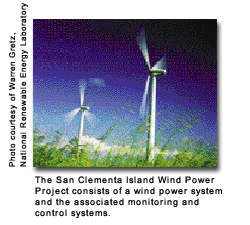 for
heating water in barracks at Marine Corps Base Twenty-Nine Palms,
California, save approximately 2.75 billion Btus per year.
for
heating water in barracks at Marine Corps Base Twenty-Nine Palms,
California, save approximately 2.75 billion Btus per year.
- To reduce the use of diesel fuel and prevent harmful emissions, the Naval facility on San Clemente Island, California, installed three 225-kilowatt wind turbines. From February 1998 to April 2000, the turbines produced two million kWhs, approximately 13 percent of the island’s total electricity needs. In FY99, the turbines helped the installation decrease consumption of 141,757 gallons of No. 2 diesel fuel, and avoided 18,450 pounds of carbon monoxide emissions. In the future, the turbines should provide 15 percent or more of the island’s electricity, further reducing diesel fuel use and emissions. The Air Force also maintains a windfarm and photovoltaic systems at Ascension Island, which reduce greenhouse gases by 2.9 million pounds of carbon dioxide per year and 103,000 pounds of nitrous oxides per year.
|
Energy Saving Performance Contracts DoD uses Energy Saving Performance Contracts (ESPCs) to identify and encourage the use of energy efficient products and technologies. DoD uses the savings from the energy efficient actions to finance the contracts. In FY99, these contracts produced savings of 1.7 trillion Btus—more than double the energy savings of the previous year. FY99 was a record year in terms of the number of awards and the magnitude of potential savings—45 contracts were awarded, with estimated lifecycle savings of $379 million. In June 1999, DoD awarded the largest-ever ESPC for five bases in the Army’s Military District of Washington. The contract guarantees annual savings of almost 600,000 million Btus, $11.9 million, 24,000 metric tons of GHG emissions, and more than 600 metric tons of pollutants that cause smog and acid rain. Another ESPC saves Tobyhanna Army Depot, Pennsylvania, more than 34 percent of the installation’s energy use each year. In FY99, contract actions saved the installation $1.3 million and more than 290 billion Btus. |
Eliminating the Use of Ozone Depleting Substances
"DoD and its people have won more EPA awards for protecting the ozone layer than any other organization in the world…Leadership and technological innovation are at the heart of our success. We believe the very same leadership and technological innovation will help us meet the current worldwide challenge to combat global climate change."
— Sherri W. GoodmanDeputy Under Secretary of Defense (Environmental Security)
DoD has made it a priority to reduce the use and emissions of ODS. These reductions are accomplished through the use of "environmentally friendly" alternatives to ODS and emissions controls where applicable. ODS destroy the strato-spheric ozone layer that shields Earth from harmful ultraviolet radiation and can contribute to climate change through global warming.
- The U.S. Military Academy at
 West Point, New York, installed a data
acquisition monitoring system in the installation’s central power plant.
This system helps comply with air quality standards through computerized
emission measurements. In 1998, the installation eliminated 1,090 tons
of CFCs and 100 pounds of halon from use, with the goal of completely
eliminating the use of these chemicals by 2003. The installation also
eliminated the use of chlorine gas and water leaks totaling 200,000
gallons daily. These initiatives save over $124,000 annually.
West Point, New York, installed a data
acquisition monitoring system in the installation’s central power plant.
This system helps comply with air quality standards through computerized
emission measurements. In 1998, the installation eliminated 1,090 tons
of CFCs and 100 pounds of halon from use, with the goal of completely
eliminating the use of these chemicals by 2003. The installation also
eliminated the use of chlorine gas and water leaks totaling 200,000
gallons daily. These initiatives save over $124,000 annually.
- Patrick Air Force Base in Florida developed a pollution prevention program that reduced the base’s use of 17 EPA hazardous chemicals by 67 percent. The installation also reduced the use of ODS by 81 percent and pesticides by 68 percent.
- McChord Air Force Base, Washington, was recognized with two awards in 1997 for using affirmative procurement: the White House Closing the Circle award and Vice President Al Gore’s Hammer award. McChord identified and implemented material substitution across the installation, resulting in an 89 percent reduction in ODS emitted in 1999.
- Dyess Air Force Base, Texas, achieved an 80 percent reduction in ODS emissions, a 75 percent reduction in nitrogen oxide emissions, a 42 percent reduction in carbon monoxide emissions, and a 39 percent reduction in sulfur dioxide emissions. The National Pollution Prevention Roundtable recognized Dyess as one of four recipients of their first annual Most Valuable Pollution Prevention Award.
- Robins Air Force Base, Georgia, reduced ODS emissions by 99 percent and chemicals on EPA’s list of the 17 most hazardous chemicals by 89 percent from the 1992 baseline. The installation virtually eliminated methylene chloride use in paint stripping operations, resulting in annual savings of $790,000 for C-141 aircraft alone. Robins also implemented an ultraviolet light disinfection system at the sewage treatment plant, eliminating the use of 8,000 pounds of chlorine annually.
- The newest and largest unmanned space booster used by the U.S. Air Force, Titan IV, provides heavy lift capability to deliver the nation’s highest priority satellites into orbit from Cape Canaveral Air Station, Florida, and Vandenburg Air Force Base, California. The Titan IV Program Ozone Depleting Substance Reduction Team reduced ODS use associated with the design, production, and launch preparation of large solid rocket motors by more than 99 percent from the original baseline of 1,330 metric ton equivalent of ODS.
- The Naval Surface Warfare Center (NSWC), Carderock Division, has been responsible for achievements in ozone-friendly air conditioning and refrigeration (AC&R) technology. NSWC’s Annapolis and Philadelphia detachments established a program for the conversion of 435 AC&R systems aboard Navy ships, replacing an installed charge of more than 45 tons of ozone-depleting refrigerant with non-ozone depleting gas. The result has been the conversion of more than 150 "CFC-12-Free" ships around the world. The U.S. Navy has been recognized by the U.S. EPA for this accomplishment with an award for stratospheric ozone protection.
- The Naval Sea Systems Command has implemented construction design standards on the Navy’s newest ships—the amphibious transport dock (LPD-17), the aircraft carrier USS Ronald Reagan, and the New Attack Submarine—that will provide ozone-friendly ships for the 21st century. To eliminate the use of CFCs, the LPD-17 design employs high-efficiency centrifugal compressor AC plants and new fine water-mist systems that protect propulsion machinery spaces. The New Attack Submarine includes AC&R systems, galley equipment systems, and maintenance and construction materials built without CFCs. These ozone-friendly technologies are available to foreign militaries and commercial industry around the world.
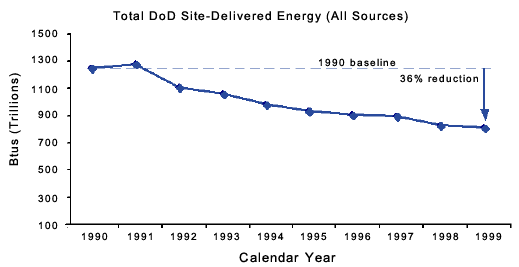
DoD has worked to reduce its total energy use since the 1970s, and has
achieved a 36 percent reduction since 1990.

For additional general information about DoD environmental programs and initiatives, contact us at:
3400 Defense Pentagon (Room 3E792)
Washington, DC, 20301-3400
https://www.denix.osd.mil/denix/denix.html
To view more information on DoD and Climate Change, refer to our website:
http://www.denix.osd.mil/denix/Public/Library/Climate/climate.html
To view information about The Importance of the Military Organisations in Stratospheric Ozone Protection and Climate Protection, refer to a link from the DENIX home page
https://www.denix.osd.mil/denix/Public/News/OSD/Climate/Brussels/workshop.html

